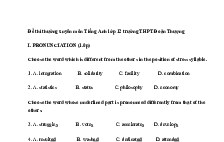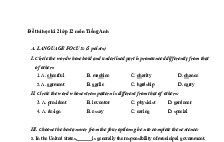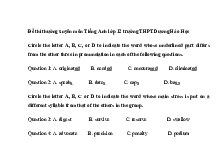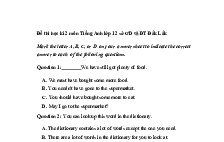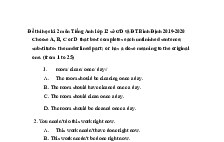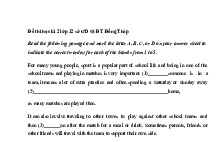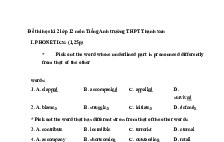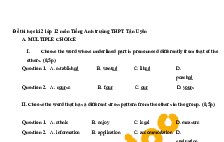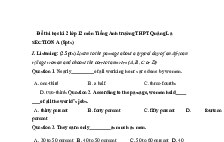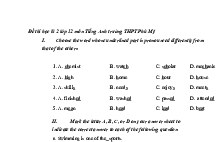đáp án đề thi học sinh giỏi tiếng anh năm 2014
Nội dung tài liệu
Tải xuốngCác tài liệu liên quan
-
![Đề thi thường xuyên môn Tiếng Anh lớp 12 trường THPT Đoàn Thượng]()
-
![Đề thi học kì 2 lớp 12 môn Tiếng Anh]()
-
![Đề thi thường xuyên môn Tiếng Anh lớp 12 trường THPT Dương Háo Học]()
-
![Đề thi học kì 2 môn Tiếng Anh lớp 12 sở GD và ĐT Đắk Lắk]()
-
![Đề thi học kì 2 môn Tiếng Anh lớp 12 sở GD và ĐT Bình Định 2019-2020]()
-
![Đề thi học kì 2 lớp 12 sở GD và ĐT Đồng Tháp]()
-
![Đề thi học kì 2 lớp 12 môn Tiếng Anh trường THPT Thanh Sơn]()
-
![Đề thi học kì 2 lớp 12 môn Tiếng Anh trường THPT Tân Uyên]()
-
![Đề thi học kì 2 lớp 12 môn Tiếng Anh trường THPT Quảng La]()
-
![Đề thi học kì 2 lớp 12 môn Tiếng Anh trường THPT Phú Mỹ]()
Có thể bạn quan tâm
Thông tin tài liệu
ĐÁP ÁN ĐỀ THI CHỌN HỌC SINH GIỎI CẤP TỈNH NĂM HỌC 2014-2015(ĐỀ CHÍNH THỨC)I. LISTENING (50/200 points) 25 50 ptsSECTION Questions 1-5 10 pts1C 2E 3A 4F 5DSECTION Questions 16 ptsQuestions 8:6B 7B 8AQuestions 13: 10 pts9. 1789 10. 1920 11. academic12. businessman famous people 13. graffitiQuestions 14 16: pts14. public buildings 15. violence violence in the society 16. feeling attitudesSECTION Questions 17-25 18 pts17. common word term household name; frequently-used word; etc18. word of mouth19. service provider20. (academic) research21. archive(s); Internet; Web; Net;etc22. academics23. (initial) capital letter G24. information25. nephewII. LEXICO- GRAMMAR (30/200 points) 30 30 ptsPart 1: (questions 26 40) 15 15 pts26. 27. 28. 29. 30. D31. 32. 33. 34. 35. B36. 37. 38. 39. 40. DPart 2: (questions 41 48)8 pts41. unnoticed42. glamorous43. surprising44. Unexpected45. increasingly46. incredible47. feverishly48. basic Part 3: (questions 49 55) ptsQuestion Line Extra word0 had49 that50 is51 can52 10 the53 13 his54 16 as55 18 notIII. READIN (50/200 points) 50 50 ptsPart 1: (questions 56 67) 12 12 pts156. 57. 58. 59. B60. 61. 62. 63. C64. 65. 66. 67. BPart 2: (questions 68 83) 16 16 pts68. in 69. such 70. that 71. ourselves72. the 73. trouble/problem 74. no 75. can76. difference 77. what 78. there 79. not80. to 81. would 82. as 83. referPart 3: (questions 84 90) 7pts84. 85. 86. 87. 88. 89. 90. Part 4: (questions 91 105) 15 15 pts 91. iii 92. 93. x94. 95. iv 96. viii 97. vii98. (human) characteristics 99. identical twins 100. signature101. 102. 103. NG 104. 105. TIV. WRITING (50/ 200 points) Part (questions 106 110) 5pts106. There is no question of supper being ready by o’clock.107. Neither (one) of us is bound by this contract until we both sign it.108. You should do not assume (that) he will help you.109. His sole topic subject of conversation was the weather.110. You are an idiot to refuse Richard’s offer of loan.Part (questions 111 115) pts111. didn’t put Anthony off in the 112. on to deny that he had done anything 113. reached got to the stage when where had no 114. for computing in reference to 115. getting mixed up in Part 15ptsModel answerThe first graph shows the trend in world population growth between 1800 and 2100, while the second graph gives predicted urban population figures for the next 25 years.The world population has experienced continuous growth since 1800. Between 1800 and 1950, the population grew slowly from just under billion to 2.5 billion people. After that, the growth rate increased and currently the figure isaround 6.5 billion. Projections show continued increase in population in the near future, but steady decline in thepopulation growth rate. The global population is expected to peak at 8.2 billion by 2050, and then decline to around 6.2 billion by 2100.The predictions also show that almost all urban population growth in the next 25 years will occur in cities of developing countries. In developed regions, on the other hand, the urban population is expected to remain unchanged at about 1.3 billion people over the next two decades.The graphs show that the global population increase will not occur evenly throughout the world, but will be greater in some areas than others.Part 4: 25 pts2Model answer :There is no doubt that some students in schools behave badly and their behaviour causes difficulty for others either because it has negative effect on the group or because ordinary students find it difficult to study with them.One solution is to take these students away and teach them on their own. However, if we simply have them removedafter one or two warnings, we are limiting their educational opportunities because it seems to me that school which caters for difficult students is sort of “prison” whatever name you give it and the people who go there may never recover from the experience. This can then cause problems for the wider society.Perhaps we need to look at why the disruptive students behave badly before we separate them. Disruptive students may be very intelligent and find the classes boring because the work is too easy. Perhaps these students need extra lessons rather than separate lessons. Or perhaps the teachers are uninspiring and this results in behavioural problemsso we need better teachers. On the other hand, most students put up with this situation rather than cause trouble, andsome people argue that we have to learn to suffer bad teachers and boring situations and that students who can’t learn this lesson need to be taught separately.So before we condemn the students to special school, we should look at factors such as the teaching, because oncethe children have been separated, it is very unlikely that they will be brought back.(255 words)The mark given to parts and is based on the following scheme: 1. Content: (35% of total mark) a. Providing all main ideas and details as required b. Communicating intentions sufficiently and effectively 2. Organization Presentation:(30%of total mark) a. Ideas are well organized and presented with coherence, cohesion, and clarity b. The essay is well-structured 3. Language:(30%of total mark) a. Demonstration of variety of vocabulary and structures appropriate to the level of English language gifted upper-secondary school students b. Good use and control of grammatical structures 4. Handwriting, punctuation, and spelling (5%of total mark)a. Intelligible handwritingb. Good punctuation and no spelling mistakes3Trên đây chỉ là phần trích dẫn 10 trang đầu của tài liệu và có thế hiển thị lỗi font, bạn muốn xem đầyđủ tài liệu gốc thì ấn vào nút Tải về phía dưới.


